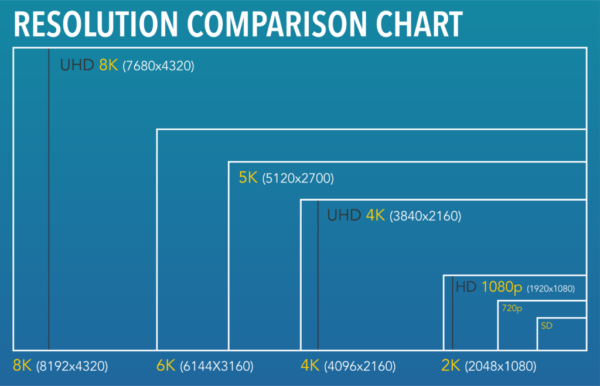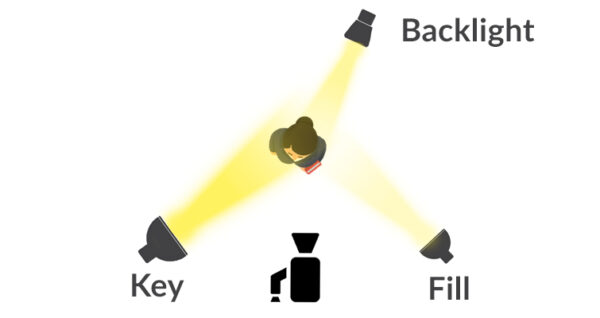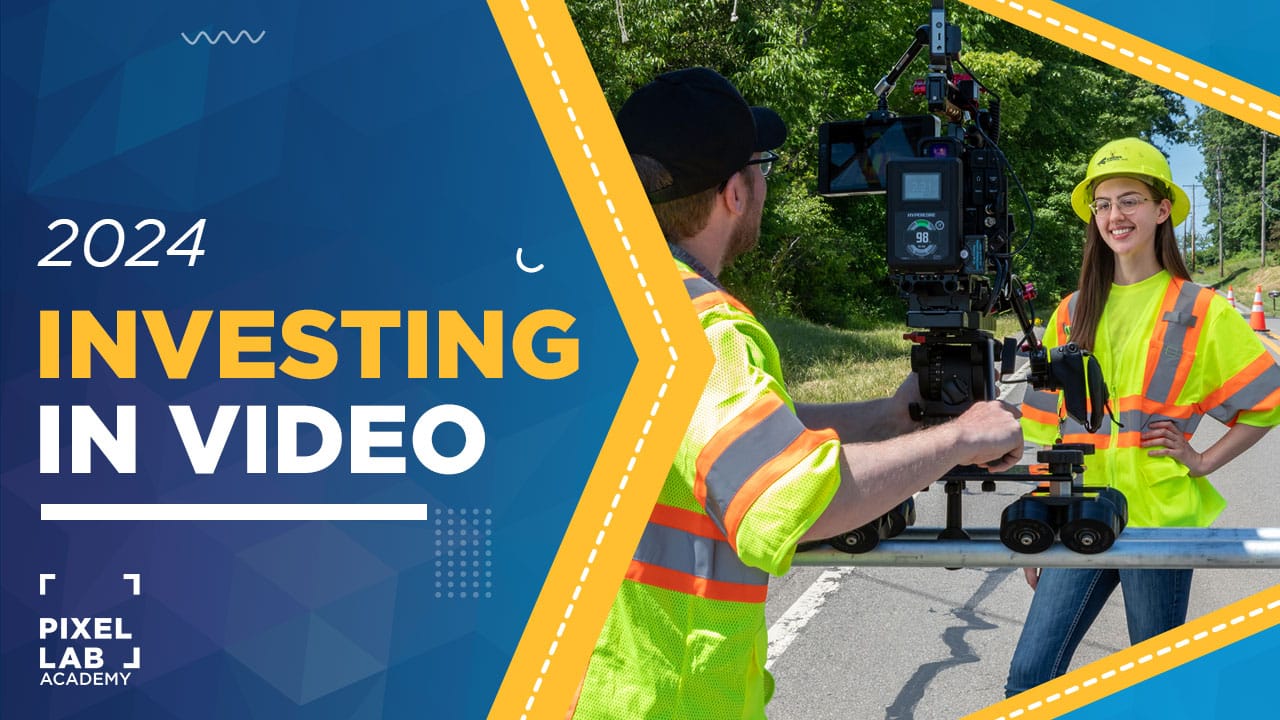
Complete Guide to Video Production for Business Marketing
The complete guide to video production gives you the tools you need to create professional video marketing content that attracts, converts, and delights to grow your business. It’s important to consider video production for your business because video continues to be the marketing tool of choice for companies, with 88% reporting that video gives them a positive ROI and 99% saying that they plan to continue using video as part of their marketing strategy. (Hubspot)
We’ll start by covering the benefits of video marketing and how your business can take advantage of it. Next, we’ll describe the video production process and look at the best types of videos to create based on your marketing goals and how to craft a compelling message. Then, we’ll set the scene with excellent audio, lighting, and composition and bring all the elements together through video editing. Finally, we’ll explain how to distribute your video to your audience and list the key metrics you should track to analyze the results.
Don’t have time to read the entire guide right now?
Get It Delivered To Your Inbox!
Unlock the secrets to successful video marketing with a free, downloadable copy of our comprehensive guide. Simply fill out the form below to receive your copy instantly.

By signing up, you agree to receive emails from Pixelab Studios with helpful tips, special offers, promotions and other information. You can unsubscribe at any time. For information about our privacy practices, please visit our privacy policy.
Complete Guide to Video Production Table of Contents
Share With Your Network!

What is Video Marketing?
Video Marketing Overview
Before we begin discussing the video production process, we want to discuss why video is so effective at engaging your audience and how your business can take advantage of it. In this section, we’ll discuss what video marketing is, why it’s effective, its return on investment, and how you can implement it. Afterward, you should better understand how to best incorporate video into your marketing strategy and the benefits it can have across your entire company.
What is Video Marketing?
Video marketing is a proven marketing technique where video content is used to showcase your product or service, educate your customers, and increase brand awareness and online engagement. If your business is not currently using video marketing, you’re missing out on a competitive advantage.
Why is Video Marketing Effective?
Your customers are seeking high-quality video content.
- A staggering 78% of people watch online videos weekly, and 55% watch online videos daily. (HubSpot)
- Mediocre or low-quality videos just won’t cut it. 62% of consumers will likely perceive a brand that publishes low-quality videos negatively, so producing high-quality video content is vital. (Vimeo)
- Video can convey complex messages more effectively than other mediums. In just a few minutes, you can inform the viewer about your product or service and inspire them to take action while entertaining them.
Video improves website SEO and increases sales.
- A website that features a video is 53 times more likely to reach the front page of Google because video increases page quality and time spent on the page. (Insivia)
- Videos increase organic search traffic by 157%. (Bitable) Plus, once visitors click through to your website, they stick around if additional video content is available.
- 90% of customers say that video helped them make a buying decision, and 64% are more likely to buy a product after watching a video. (Forbes)
Video improves engagement on social media platforms.
- 85% of users want more videos from brands on social media. (Wyzol)
- 93% of companies have acquired new customer(s) through social media video marketing. (Animoto)
- Users on social media share video content twice as often as any other type of content. (Wyzol)
Viewers retain 95% of messages via video and 10% via text.
- On average, viewers retain 95% of a message when they watch it in a video, compared to only 10% when reading it in text. (Insivia) Video engages a customer’s visual and auditory senses, providing a more stimulating experience.
Video builds and maintains trust with your audience.
- Video lets your clients and prospective clients see your product or service in action, getting a complete grasp of its features and benefits. It also allows them to get to know you, your brand, and your mission. Giving customers the option to watch a video builds customer confidence in a product and increases conversion rates.
Video Production Investment & ROI
How much does it cost to produce a marketing video?
- The cost of producing a marketing video depends on several factors, including the number of filming days required, the complexity of the final product, and the number of actors and crew members needed. You can get a sense of how much it will cost to produce a video for your company by using our Instant Estimate Tool.
Consider video content as an operational cost of your business.
- On the surface, video marketing appears to add additional costs to your marketing budget. But remember, when you think about the video(s) you’re producing as operational costs of running your business – the investment made in creating these advertising, marketing, and sales tools will bring in a much greater return than your original investment.
Create effective communication video content to lower operational costs.
- By replacing your most commonly used communications with video (employee training, customer support inquiries, safety information), you are creating an investment that ensures your most important messages are delivered effectively and efficiently. The right video deployed at the right time and place can completely transform an entire business while lowering operating costs.
Visit our article to learn more about how much a corporate video costs and how to maximize your video marketing budget.
How to Implement Video Marketing Across Your Company
Video is an asset you can use across your entire company (Marketing, Advertising, Human Resources, Finance, and Operations) to drive business value, increase efficiency, and effectively distribute your messaging.
- Many types of corporate videos can be used across your company. Companies initially turn to Marketing and Advertising videos, which can increase revenue and brand awareness. However, video is an asset you can use across all of your departments.
- Your Human Resources department can utilize recruitment videos to entice new talent, orientation videos to onboard that new talent, and training videos to simplify team training.
- Your Finance department can create videos showing your company’s latest financial reports and quickly distribute that information to your board members and investors.
- The Operations department can create training and safety videos for your employees to streamline efficiency in the workplace.
Overall, it’s important to remember that creating video content isn’t a “one-and-done” process. The key is consistently creating engaging videos for your audience. We know it can seem daunting and time-consuming, but remember these three items when planning out your content creation:
- Commitment – commit to a timeline
- Calendar – put it in the schedule
- Content ideas – create a list/brainstorm

How To Create A Video Marketing Strategy
This section will discuss how to create a winning video marketing strategy. We’ll go over setting goals for your video campaign, identifying your target audience, choosing the type and style of video that complements your message, and determining the length of your video to boost engagement. Afterward, you should be ready to craft a script that speaks directly to your audience.
Determine Your Video Marketing Goals
First, you’ll need to define your goals and be prepared to measure the results. Do you want to convert leads, increase brand awareness, or sell more tickets to your event? Knowing what you want to accomplish with your video is essential before you begin writing the script. When setting goals, be sure your goals are SMART, an acronym for Specific, Measurable, Achievable, Relevant, and Timely. Increasing brand awareness is a good start to your goal, but a SMART goal would state: I want to grow my number of likes and shares on Facebook by 10% by the end of the second quarter of this year.
Identify Your Target Audience
Next, you want to analyze your target market. You want to stand out from your competition, but choosing a video type and style that fits your brand and goals is also essential. Once you better understand your audience and their pain points, you can develop video content that connects with them to build brand awareness and trust in your company. Knowing your audience will also determine where you should publish and promote your video content.
Understanding the Buyer’s Journey
The Buyer’s Journey is a three-step process that shows the journey a buyer takes before committing to a product or service.
- Awareness – Your buyer is researching solutions to their problem. It’s vital that you deliver the answers that they’re seeking during this stage.
- Consideration – Your buyer has a better understanding of their problem after researching it and is looking for a solution. You need to show them how your solution will solve their problem.
- Decision – Your buyer is ready to buy and needs content that makes them feel confident about their investment.
Once you know this information, you can better speak to your audience based on where they are in the Buyer’s Journey. It can be tempting to create one video that speaks to all of these stages, but it’s more effective to make separate videos with a message that communicates to audiences at each step of the Buyer’s Journey.
Please read our article on the types of videos that work best at each stage of the Buyer’s Journey to learn more.
Choose The Video Type
There are several types of videos that you can create. The following are just a few examples:
Promotional Video – Promotional videos showcase your product or service to potential customers.
Recruitment Video – Recruitment videos are used to recruit top talent to your company by showcasing your company and its values.
Safety Video – Safety videos help to reduce on-the-job accidents and injuries by educating employees and the public.
Commercial – Commercials are short (typically 60 seconds or less) advertisements that promote your company, product, or service.
Demo Video – Demo videos explain how your product or service works to prospective customers.
Event Video – Event videos excite attendees by showing them what they can expect at your upcoming event or recap the best moments from a past event.
Testimonial Video – Testimonial videos feature positive comments from existing customers who endorse your product or service. Check out our article about how to boost sales and build trust with customer video testimonials.
You can find an extensive list of video types in our article about using video across your company.
Choose The Video Style
You can incorporate five styles of videos into your marketing strategy. Each style of video outlined here is in varying scenarios, and your video type and message will dictate which style will work best.
Docu-Style – Docu-style videos are documentary-like interviews in which title screens are incorporated along with the interview and b-roll footage to narrate the story visually.
Voiceover – Voiceover videos are similar to Docu-style videos; however, they utilize a professionally recorded voiceover artist to provide the narration instead of an on-camera interview.
Typography – Typography videos communicate your story with animated text on-screen alongside the footage. This type of video is excellent for explainer-style videos, especially when viewers are watching but not listening to the content.
Narrative – Narrative videos are the most dramatic, flexible, and creative type of videos you can create. Narrative videos often feature a cast of characters that act out a scripted story.
Demo Reel – Demo Reel videos, also known as Highlight Videos or Sizzle Reels, feature short video clips with music in a highly stylized manner.
Visit our article to learn more about the five styles of marketing videos and the positives and negatives of each.
Video Length & Engagement
Gaining your consumers’ attention quickly is crucial, so you must carefully consider how long you make your videos. A general rule of thumb is to keep your videos under two minutes in length, especially if you’re posting to social media platforms. If you post your video to YouTube, you can get away with longer-form videos, typically up to ten minutes, before losing engagement. It’s also common to create multiple versions of a video at varying lengths to further boost engagement on each platform.

What is the Pre-Production Phase?
What is Video Production? What Are The Stages of Video Production?
Video production is the process of creating video content from creative concept to finished product. The video production process consists of three phases: Pre-Production, Production, and Post-Production.
Now that you understand what video marketing can do for your business, it’s time to start creating a video!
What is Pre-Production?
The pre-production phase of the video production process includes everything you need to do before filming, including hiring a video production company, creating a script, and developing a shot list.
Hiring A Video Production Company
Suppose you don’t have the time, patience, or know-how to produce a video marketing campaign on your own. In that case, hiring a professional video production company to handle the heavy lifting for you can be beneficial. The video production company will be able to write the script, create a shot list, assemble the cast and crew, capture the footage, and bring it all together during the video editing process. Additionally, you will get a better-looking and sounding video to ensure your brand looks (and sounds) its best. Companies offer many different video production services, but the most common include corporate, commercial, and event video production.
To learn more about how a professional video production company can elevate your brand, visit our article regarding why you should hire a video production company.
Writing a Video Script
Follow these five steps to craft a successful script:
- Introduction – It’s crucial to grab your viewer’s attention within the first few seconds. Explain what they can expect and convince them to continue watching.
- Setting the story – Communicate that you understand your audience’s pain point and can provide relief.
- Value proposition – Explain how your solution will impact their lives.
- Hook – Explain what’s unique about your solution and what sets it apart from your competition.
- Call To Action – Tell your viewers the following action you’d like them to take, which could include visiting your website, calling your phone number, or downloading your app.
Check out our articles for more guidance on how to write a compelling video script that converts and how you can build trust with story-driven corporate videos.
Selecting A Filming Location
When selecting a filming location, consider whether you want to use the actual space in the shot or invest in a backdrop.
- Studio Space – If you decide to turn your space into a studio, consider adding objects and colors to the scene to create visual interest without causing distractions. Avoid filming against a blank wall and experiment with the camera’s location to add depth and personality to the scene.
- Backdrop – If you don’t have access to a great-looking location, consider investing in a backdrop. Backdrops come in various colors and styles; however, a solid white or black backdrop is often a safe choice as it creates a clean and minimalist look. If you want to go a step further, a green screen will allow you to place yourself in any location; however, you should avoid it if you don’t have experience filming with one. A green screen must be carefully lit and prepared to provide an acceptable result.
Before settling on a filming location, keep a few things in mind.
- The location should, in some way, complement your story. For example, if you are creating a promotional video for a doctor’s office, you might want to film it in an examination room.
- Make sure the location is quiet, and the production won’t be disturbed by the usual business of the day. Check for HVAC systems, refrigerators, and vehicle traffic noise.
- Ensure that the cast and crew have access to parking, power outlets, bathrooms, and other amenities.
- If you’re not filming at your office, it’s important to secure permission to film at the location or determine if permits will need to be acquired beforehand.
Creating A Shot List and Storyboard
A shot list is handy to ensure you get all the shots you need on the video production shoot. A shot list is a checklist of all the shots required to tell the story. A shot list will also help keep the production on schedule and budget. Having a clear plan of attack before the camera begins rolling is critical to avoid wasting time and money. Create a storyboard to communicate your video’s look and style with your team. In addition to a list of shots, a storyboard includes images showing how the final video will look.
Assembling The Video Production Cast and Crew
If you are planning on hiring a professional video production company to manage your shoot, they will be able to handle all of these tasks for you. Otherwise, you will need to assemble these elements yourself in addition to hiring the crew members and actors required to execute the production of your video. Inform the cast and crew of their requirements on the day of filming, and create a schedule to ensure you have the time to capture all the shots needed.
Don’t have time to read the entire guide right now?
Get It Delivered To Your Inbox!
Unlock the secrets to successful video marketing with a free, downloadable copy of our comprehensive guide. Simply fill out the form below to receive your copy instantly.

By signing up, you agree to receive emails from Pixelab Studios with helpful tips, special offers, promotions and other information. You can unsubscribe at any time. For information about our privacy practices, please visit our privacy policy.

What is the Production Phase?
What is Video Production?
The production phase of the video production process involves the actual filming of your video. While the look of your video is important, many factors determine the overall quality and effectiveness of a video. We will cover selecting the best settings for your device, how to capture great audio, framing your shot, and lighting your scene to get the best-looking video possible. Afterward, you should understand how to craft high-quality video content so your brand looks (and sounds) its best.
Before You Hit Record
Check your battery level and storage space.
- Whether with your smartphone or a professional cinema camera, checking your device’s battery level and storage capacity before beginning to film is essential. Charge your battery or plug your device into a wall outlet or portable battery and backup and delete any previously captured footage to ensure you have enough storage space to film to completion.
Clean your camera lens before filming.
- Whether using a smartphone or a DSLR, the camera lens collects dust, lint, and fingerprints over time. Use a clean microfiber cloth to clean your lens before filming.
How To Capture Great Video
While these settings and techniques apply to many popular devices, you should consult your device’s instruction manual for specific details.
- Setting Camera Resolution – A digital video image is formed by a rectangular grid of pixels and is displayed as width x height. The most common resolutions are 720p High Definition (1280×720 pixels), 1080p Full High Definition (1920×1080 pixels), and 4K Ultra High Definition (3840×2160 pixels). The image below shows how each of these resolutions relates to one another. For example, 3840×2160 has four times as many pixels as 1920×1080. Generally, the higher you set your resolution, the more detail you capture and the more flexibility you’ll have when editing. However, recording at a higher resolution also means that your video file will be much larger, so you’ll want to consider your storage options first.

- Setting Camera Frame Rate – All the pixels in an image are known as the frame. The frame rate refers to the number of frames recorded each second. The most common frame rates in the United States are 24fps (frames per second), 30fps and 60fps. So, if you set your device to capture at 30fps, each second of video will display 30 frames. The more frames you record each second, the smaller the difference from frame to frame, and the image will feel smoother. The fewer frames you capture each second, the more significant the difference from frame to frame, and the image will begin to stutter. There is no right or wrong choice when it comes to frame rate. It’s a matter of preference based on what you’re trying to create. 24fps is commonly used in the film industry and is considered cinematic, while 30fps has been the television standard for many years. Some devices let you capture video at higher frame rates, like 60fps or 120fps, which can be played back in slow motion.
- Advanced Camera Settings – Some cameras offer additional settings to dial in the look you require, including Shutter and ISO, which will adjust the brightness of your image, and White Balance, which will alter the color of your image based on your location’s lighting.
How To Capture Great Audio
Capturing high-quality audio is more important than high-quality video, as viewers will stop watching your video immediately if the audio is terrible. That’s why it’s imperative to capture it properly, which is why we recommend investing in a high-quality microphone and recording in a quiet, controlled location.
- Microphone Recommendations – We recommend using a lavalier or shotgun microphone plugged directly into your device or an external audio recorder. Compared to your device’s internal microphone, it will sound significantly cleaner and clearer and be less distracting to the viewer.
- A lavalier is a small microphone that clips below your subject’s collar and can be either wired or wireless. A lavalier microphone is an excellent option that allows you to place it very close to the subject, which is paramount to capturing excellent quality audio. The downside is that the microphone will most likely be seen and can distract the viewer if not appropriately hidden. Also, most lavalier microphones capture sound from every direction, so it might not be the best option if you’re filming in a noisy environment. Be sure to hide the lavalier wire underneath your subject’s clothing and position it so that the microphone is on the outside of the clothing.
- A shotgun microphone is placed atop your device or just out of the frame and pointed at your subject. For the most part, shotgun microphones capture sound directly in front of it, so it’s a great option if you’re filming in a noisy environment. The downside is that placing it correctly to get quality audio is a bit more challenging. Be sure to put it just out of frame so it’s as close as possible to your subject without being seen on camera.
- Controlling Your Environment:
- Remove noisy jewelry and eliminate distracting noises such as air conditioners and refrigerators.
- Choose a quiet and secluded location to minimize outside noise and distractions.
- Choose a location with as little echo as possible. To test how much the room echoes, clap your hands and listen. If an echo is present, find a room with heavy furniture and carpeting to soak up the sound.
- Check Your Audio:
- Before you begin rolling, test the audio by recording a few seconds of video and playing it back with a good pair of headphones. You’ll want to check that the microphone is not rubbing on clothing or picking up unwanted noises.
Framing Your Shot
- Types of Shots – Shots fall into three main categories:
- Wide Shot – Wide shots establish the location and show the viewer the entire scene.

- Medium Shot – A medium shot is captured at a medium distance and cuts off your subject around the waist. This type of shot is common in interviews and vlogs.

- Close Up – A closer shot that’s zoomed in to show your subject’s face or an object for detail. This type of shot is great for focusing your viewer’s attention on a specific area of the frame.

- Capturing B-Roll – While filming, be sure to capture ample amounts of b-roll. B-roll is additional footage that supports your message and is also used to cover editing cuts. Capture multiple types of shots from varying distances and angles to add visual interest to your video. Your b-roll footage can also be recycled for other projects, reducing the work needed for future content.
- Tripod – After investing in a quality microphone, you’ll want to consider a tripod to hold your camera. If you cannot secure a tripod, use a stack of books or windowsill to keep your camera steady and elevate it so that you’re filming at eye level. Just make sure that your camera is level before you begin rolling. Tripods often have a built-in bubble level, and most smartphones have a built-in digital level if a bubble level isn’t available.
- Adding Motion – Adding motion to your b-roll footage is a great way to create a more dynamic video, but avoid going handheld. Instead, consider using a gimbal to get smooth, dynamic shots.
- Placing Your Subject – There are a few rules to remember when framing your subject.
- Rule of Thirds – The rule of thirds is a common technique used to create a sense of balance in your image by splitting the frame into two horizontal lines and two vertical lines and placing crucial elements at the intersection of these lines. You may have noticed these lines when you open your device’s camera app. Avoid placing your subject in the dead center of the frame, as it lacks visual interest. Instead, use the rule of thirds to add interest and focus the viewer’s attention.
- Headroom and Lead Room – Headroom refers to the space between the top of the subject’s head and the top of the frame. Lead Room refers to the amount of space between the subject and the edge of the frame. Not leaving enough space around your subject can make the viewer feel uncomfortable.
- Eye Level – In most cases, placing your camera at eye level with your subject is best. Setting the camera above or below your subject tends to be unflattering and will communicate something to the viewer that you may not intend. For example, placing the camera above your subject will make them appear weak while putting it below will make them seem heroic. Also, if you’re filming yourself, look directly into or slightly above the camera lens to connect with your audience and avoid looking at yourself on the screen. It’s a subtle difference, but your viewer will be able to tell. It helps create a sense of intimacy and comfort for your audience and keeps your viewer’s attention and engagement longer. Our tips on presenting yourself on camera like a professional and what to wear for your video shoot will help make you more comfortable and better prepared to be on camera.
Lighting The Scene
- Basics of Lighting – Lighting is the most critical aspect of capturing high-quality video and should be considered when selecting a filming location.
- Three-Point Lighting – The most common type of lighting setup is known as three-point lighting. This setup involves placing three lights around your subject and wrapping them in light. Using this setup is not required, but it’s a good rule to follow when possible. Try experimenting with different lights and setups to find the best one for your situation.

- Key Light – The first light is your key light and is typically the brightest light of the three. Place the key light at a 45-degree angle to the left or right of the subject. The light should be raised above the subject’s head on a light stand and aimed down to illuminate the subject’s face.
- Fill Light – Next, place the fill light on the opposite side of the key at a 45-degree angle. The fill light is used to fill in the shadows that the key light casts and is typically less bright than the key light. You don’t want to eliminate shadows completely, however, as those are what give your subject dimension.
- Backlight – Finally, the backlight will be placed behind the subject to create a subtle rim of light behind their head to separate them from the background and further add depth to the scene. Just make sure that the stand is out of the shot.
- Lighting Tools:
- The sun is an excellent light source and can act as your key light; however, it can be too bright if not softened. Use blinds to adjust the amount of light hitting your subject or film on a cloudy day to soften the light and reduce harsh shadows.
- If you cannot invest in professional lighting equipment, you can use items around your home or office to get similar results. Place lamps around your subject to mimic the three-point lighting setup. Use a bed sheet to bounce the light or shine it through a clear shower curtain to diffuse and soften the light.
- Lighting Tips:
- Avoid using the sun as a backlight indoors, as it will silhouette your subject. Instead, let the sunlight be your key light and utilize less intense sources as your fill and backlight.
- Avoid filming with overhead lights as they cause unflattering shadows on your subject’s face. Instead, turn off overhead lights, place lights around your subject, and follow the three-point lighting rule.
- Filming outside with no clouds can be challenging without the right tools to modify the light. Try finding a spot with lots of shade to avoid overexposing your image.
- Not all lights produce the same color of light. Our eyes can adjust to these shifts in color; however, cameras are not as intelligent and rely on you to set the correct white balance based on the environment you’re shooting in. For example, incandescent bulbs typically produce a warm (i.e., amber) tone. Fluorescent lights give off a slightly cooler (i.e., blue) tone, while sunlight appears even cooler. Your camera may try to white balance automatically, but mixed colors can confuse your camera and cause your subject’s skin tone to appear off, so avoid mixing light unless you’re doing it for creative reasons.

What is the Post-Production Phase?
What is Post-Production?
The post-production phase of the video production process includes editing all of the elements you captured in the production phase together to create the final product. This phase includes organizing and backing up your footage and editing the footage, music, sound effects, and other elements together with a video editing program.
Shooting for the Edit
When filming your content, remember that what you film will need to be edited at some point—keeping this in mind while filming will save you headaches during the editing process.
- Shoot more than you feel is necessary, as the video editor will most likely need it. While your video may only be one minute long, your editor might need substantially more footage to create an engaging video. Be sure to capture ample b-roll footage to supplement your story and ask a few more questions you feel you need during the interview to ensure you have what you need when it comes time to put it all together.
- While filming, leave a buffer at the beginning and end of each clip so that your editor isn’t cutting too close to an important shot. It gives them extra flexibility when choosing the best section of a clip.
Organizing Your Footage
File Structure:
- After the shoot, you’ll want to back up the footage to another device to organize and protect it from being deleted. Instead of dumping all of your files in one folder, create several subfolders for things like footage, images, and audio files within one main project folder to keep things nice and tidy. It will save you or your editor hours of work as all your files will be neatly organized and ready for editing. Plus, video editing programs are very particular about keeping your folder structure consistent. If anything changes after you’ve already begun editing, you’ll need to show the program the new location of the files, so it’s good practice to have a consistent folder structure and naming convention and stick with it.
Backing Up Your Project Files:
- Once you organize your files, store two exact copies of your project on external drives. If you want to go a step further, keep one copy locally and one at another location to decrease the chances of losing the project due to theft, fire, or natural disaster. You can also upload these files to an online storage solution like Google Drive or Dropbox; however, this typically involves a monthly subscription and can be time-consuming, depending on your internet connection.
Recommended Video Editing Programs
Now that your footage has been recorded and organized, it’s time to piece it together in the post-production phase! I will walk you through the most popular video editing applications available, but this is by no means a complete list.
- Video Editing Apps – Video editing apps running on your mobile device are a convenient way to begin the editing process quickly; however, the experience is limited compared to dedicated desktop programs.
- Adobe Premiere Rush (Subscription – iOS and Android)
- iMovie (Free – iOS Only)
- LumaFusion (Paid – iOS Only)
- FilmoraGo (Free – iOS and Android)
- KineMaster Pro (Paid – iOS and Android)
- Free Basic Video Editing Programs – These programs are best for beginners who want additional features and flexibility.
- Free Professional Video Editing Programs – These options are best if you want access to even more professional features without the price tag.
- DaVinci Resolve (Free – macOS and Windows)
- Lightworks (Free – macOS and Windows)
- HitFilm (Free – macOS and Windows)
- Paid Professional Video Editing Programs – These options are for the true professional who doesn’t mind spending the money for the best of the best.
- Adobe Premiere Pro (Subscription – macOS and Windows)
- Final Cut Pro (Paid – macOS Only)
- Avid (Paid – macOS and Windows)
Finishing Touches
- Add Music – Add music based on your audience and the overall tone of your video.
- Add Bumpers – Include your logo and contact information at the beginning and end of your video, including your website URL, phone number, address, and social media profiles.
- Export Your Video – Every video platform has its unique video specification requirements. Once you’re ready to export your video, check with those platforms to ensure that it matches their specifications. This Google Doc is an excellent resource for reviewing each platform’s various social media video specs.

Where Should I Publish My Video?
Distributing Your Video Content
Now that you’re on the other end of the video production process, you need to get your video in front of as many of the right people as possible. Where you place your videos is almost as important as the content itself. So, we will discuss distributing your video to the platforms your audience visits the most. We will cover distributing your content to all major video platforms, including social media sites like Facebook, Instagram, and YouTube, embedding it on your website, increasing your rank in Google search, expanding your reach with paid advertising, and broadcasting your video with television distribution. Afterward, you’ll be ready to determine the best platform for your content to reach your goals.
Learn how to optimize your YouTube videos for search to maximize your reach.
Finding Your Audience – Social Media
If you don’t currently plan to use your video on social media – you’re missing out on an excellent opportunity to reach your audience. Remember, each social media platform varies in the style of content you can upload and share.
Also, it’s important to realize that not every viewer will be listening to your video. By adding captions, you can reach not only your deaf and hard-of-hearing viewers but also those who choose not to listen while they watch your video. Captions are also a great SEO tool, which we’ll discuss in more detail later. Captioning your video increases the average view time by 12%.
- Facebook – Facebook favors video content above all other types of content, resulting in higher reach and customer engagement for businesses that take advantage of it. Click here to learn how to upload a video to Facebook.
- Instagram – With more than 15 million business accounts, Instagram is a fast-growing marketing platform for businesses, with sponsored video content receiving 3x the engagement as photos. Click here to learn how to upload a video to Instagram.
- YouTube – With an ever-expanding library of new and original content, YouTube has become the best option for more robust topics requiring detailed viewing. Click here to learn how to upload a video to YouTube.
- LinkedIn – If you’re a B2B company, chances are you’re already using LinkedIn. Video use on LinkedIn is growing fast – and it’s a great place to advertise and share your brand with other B2B businesses. Click here to learn how to upload a video to LinkedIn.
Finding Your Audience – Web & Google Search
- Website – Once you have your video content ready to share, it’s imperative to upload or link your video to your website. Not only will potential customers be looking at your website for more information, but your current customers will also frequently check in for details, updates, and more. Take advantage of this opportunity to create shareable content on your site.
- Google Search – As the number one ranked search engine, Google is the place to be when your audience begins their Awareness stage of the Buyer’s Journey. More often than not, people start their search for a pain point they may not yet fully understand. They are not necessarily looking for a solution yet; however, if you position yourself within the top results, you’re planting the seed for them when they are ready to commit to a solution. Google shows video content near the top of their search results on the first page. If your website ranking isn’t as high as you’d like, you can utilize your video content to raise your brand awareness – as your videos will appear on the first page of a keyword search.
- Paid Advertising – Rather than relying on organic reach, you can use paid advertising on social media platforms and search engines to further improve your brand awareness. Paid advertising allows you to reach a new audience segment that may not have found you organically. While it’s not necessary to begin paid advertising on all platforms, it’s wise to analyze where your target audience spends most of their time and implement paid advertising there.
Finding Your Audience – Broadcast Television
- Television Advertising – Broadcast television advertising is excellent at targeting a narrowly defined audience base, thereby increasing your brand visibility directly to those individuals in your target market. Broadcast TV commercials enable brands to be associated with the most-watched programming on television for increased visibility and credibility.

How Do I Promote My Video?
Promoting Your Video Content
You’ve created a fantastic video, distributed it to your audience, and now need to ensure it has the best possible chance of succeeding! This section will focus on the many ways to promote your video content and ultimately increase your return on investment. We’ll discuss branding and repurposing your videos, creating visually appealing video packaging, and optimizing your content for search engines. Afterward, you’ll have an attractive video package that your audience will have no choice but to watch.
Branding & Repurposing
- You can continue boosting your ROI by placing your video on your homepage or email signature for extra exposure. Displaying your video gives your audience the answers they need quickly.
- Adding a video to your homepage will keep visitors on your site longer, which is excellent for boosting your Search Engine Optimization.
- Adding a video to your homepage or landing page can also increase conversion rates.
- Insert your video into an email signature and provide a way for the reader to share your video with new contacts and valued customers.
- Use condensed videos as a sales tool to assist your sales team.
- We know consumers have a short attention span, so it’s crucial to provide them with information quickly and concisely. Consumers are much more likely to buy after watching a video. Your sales team should have video accessible to them on their devices, giving them an advantage in their sales meetings.
Video Packaging
- Custom Thumbnails – As consumers, we love the packaging. Depending on the product or service, we’re apt to respond to the company’s packaging in different ways – both negatively and positively. Video packaging is not any different. Create a thumbnail that stands out and relates to the content of the video.
- Video Titles – Similarly, include a catchy title describing the video while also grabbing the viewer’s attention.
- Company Logo – It’s also essential to include your branding and logo at the beginning and end of each video to increase your audience’s recognition and association of your brand with quality and credibility.
SEO Optimization
When investing in video marketing content, it sadly isn’t as easy as uploading your video to a platform and instantly watching the views pour in. You have to be SEO savvy to outsmart your competitors. Start with keyword research, a title, and tags.
- Keywords added to video and online content improve search engine rankings for those terms. Place the most influential keywords in your title based on your topic and keyword research.
- From an SEO perspective, the title of your video is the most critical item on the page. With that said, it’s important to keep your title short – under 60 characters to avoid getting cut off in the search results pages. A great title is only great if it can be read and found by your audience.
- Lastly, meta tags are another way to get your video in front of your intended audience. Meta tags provide data about your video or webpage to search engines and website visitors.
View our top 6 strategies to promote your marketing video for more ways to maximize results.

How Do I Measure the ROI of My Video?
Analyzing Video Performance
Now that your video has been produced, distributed and promoted, you need to analyze it. Otherwise, you’ll never know if it’s working as intended. In this section, we will discuss how to measure and track the most relevant metrics to indicate whether your video was a success. Afterward, you’ll know if adjustments are needed to your campaign to boost your results.
Tracking Metrics
The first step to tracking video metrics is clearly defining your goal – which you should’ve determined when planning your video marketing strategy. Remember – you can’t manage what you don’t measure! And you can’t measure what you don’t define!
- It’s vital to perform A/B testing with your video as well. Along the same lines of “you can’t manage what you don’t measure,” it’s also true that you can’t determine what your audience didn’t like about your video if there isn’t an alternative for them to enjoy. That’s why it’s crucial to provide your audience with multiple versions of your video – each with varying components to determine which message, music, graphics and length are most successful.
Determining KPIs – Key Performance Indicators
- Once you have your SMART goals set, you’ll need to determine which factors you should monitor to measure the success of your video. Key Performance Indicators, or KPIs, are those factors that you select to measure over a given period to determine overall performance and success.
KPIs To Watch
Take advantage of each platform’s analytics section to track your metrics quickly and efficiently.
- View Count – View count is the number of times someone has watched your video. It’s often referred to as “reach.” View count is a great metric to track if your goal is to increase brand awareness and shares between audience members. However, it’s crucial to understand how each platform classifies “views,” which vary widely between platforms. While view count can be an essential measure of brand awareness, many other metrics can be beneficial to monitor.
- Engagement – Engagement is a large category of metrics, including likes, shares, and comments – and monitoring varies between each social media platform. When tracking engagement, it’s vital to understand how much your audience interacts with your brand and how often.
- Likes, Shares, Comments – Likes, shares, and comments are a great way to measure your content’s relevance to your audience. For example, if your audience feels compelled to like, comment on, and share your video with their friends and family – that’s a good indicator that your content was engaging and relevant. Also, remember that the more your video is shared, the more it’ll be viewed – which means the larger your audience becomes. Social engagement metrics are good KPIs to track if your goal is to reach as many people as possible.
- Conversations – Conversions are when your viewer takes the action you desire after watching your content. Conversion rate compares the number of times viewers completed your Call To Action (or CTA) with the total number of clicks or completions on your CTA. For example, if your goal is to have your viewers complete a form on your website for a free trial, you’ll want to compare the number of people who click the link to get to your website vs. the number of people who complete the form. Placement and distribution of your video affect conversion rates, so consider testing distribution on your website home page and social media platforms to see which gives you the best conversion rate.
- Play Rate – The play rate compares the number of people who played your video with the number of impressions it received. This metric is vital in determining how relevant or appealing your content is. For example, if thousands of people see your video through your audience sharing it, but only a handful of people play it, you know there is a disconnect worth exploring within your video.
- Website Metrics – Along with conversion rate, bounce rate, and time-on-page are also good metrics to monitor when your end goal is increasing website traffic. Tracking page bounce rates (or the rate at which people visit your site and immediately leave) and the number of times people spend on the page before they close it are good indicators of relevance and engagement to your website. Be sure to compare the metrics before and after you add your video to your website.
- SEO Ranking – While it is common for brands to consider their website in terms of SEO ranking, several factors influence this value. One of the most important is the SEO applied to your content – specifically your video content.
- The number of links generated through sharing your video can increase your overall SEO ranking, showing that your video is valuable and shareable.
- By increasing your overall website retention time, you can also increase your overall SEO ranking, as this shows you’re providing helpful and valuable information to your audience.
To learn what formula you should use to calculate your video marketing ROI, visit our article.
Congratulations! You are well on your way to understanding the video production process and creating great video content to grow your business! By now, you’ve crafted a compelling message based on your goals, produced a great-looking (and sounding) video, and distributed and promoted it to the most relevant platforms based on your audience. At this point, your next goal is to continue tracking the results and make adjustments necessary to see even more significant growth or create another video to achieve a different goal.
At the beginning of this article, one of the many outcomes was to launch a successful video marketing campaign from content creation to distribution to promotion. We’re finally at that step, but remember, the journey doesn’t stop here. It’s only just begun! The key is consistently creating video content to continue to engage and delight your audience. You now have the tools to develop an effective and repeatable process to leverage your new skills to grow your business! You’ve taken a significant step towards success with video production, and we hope you enjoyed it.
Do you need help creating videos?
At Pixelab Studios, we’re passionate about helping our partners create story-driven marketing videos that attract, convert, and delight. Click the button below to get started.

Brandon Roudebush
Founder, Executive Producer – Pixelab Studios
Since founding Pixelab Studios in 2015, my passion has always been working alongside incredible people to tell stories in a genuine and authentic way. Not only am I proud of the number of clients we’ve helped, but I’m proud of the meaningful relationships we’ve formed along the way. With a proven track record of delivering engaging videos with a delightful customer experience, we can’t wait to show you how impactful, fun, and rewarding it can be to partner with us on your next video project!




